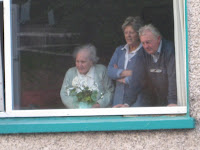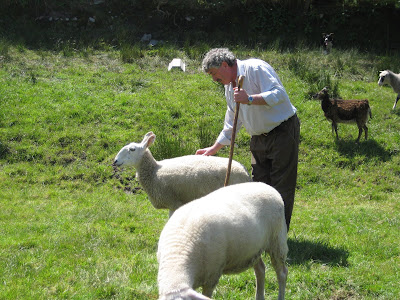
I have changed the name of this blog. I now live, since August of 2019 in the New Liberties section of Central Philadelphia. And the truth is that I have not pursued much serious birding since coming to Philadelphia. But I intend to. I am still a Redemptorist and Roman Catholic missionary priest. I believe that God wants us to love, respect and care for ALL of creation as our Pope Francis says so well in his quite long letter LAUDATO SI which is about care for all of creation
Friday, June 12, 2009
A Wonderful World of Irish Birds and Trees
 These days in Ireland have been wonderful. At Glencough near Mountcharles-Co. Donegal is the place where our maternal grandfather, John McDermott, was born and raised before going to America to provide a place for us. At his grand nephew's house, Patsy McDermott, besides seeing the ivy covered remains of the family barn and home, I saw what I think were Chiff Chaffs or Willow Warblers. I also saw the most beautiful Irish Goldfinches which have a red ring on their head besides the yellow and white wing patches. The most frequent birds here are: magpies, Black Thrush, Chaffinches, European Robin, Rooks, Jackdaws, Goldcrests, Collared Doves (which some people mistake for Cuckooes because they "sound" like a cuckoo), the Swallow (which is actually what we call "Barn Swallow" elsewhere), Tree Swallow, which are quite numerous....
These days in Ireland have been wonderful. At Glencough near Mountcharles-Co. Donegal is the place where our maternal grandfather, John McDermott, was born and raised before going to America to provide a place for us. At his grand nephew's house, Patsy McDermott, besides seeing the ivy covered remains of the family barn and home, I saw what I think were Chiff Chaffs or Willow Warblers. I also saw the most beautiful Irish Goldfinches which have a red ring on their head besides the yellow and white wing patches. The most frequent birds here are: magpies, Black Thrush, Chaffinches, European Robin, Rooks, Jackdaws, Goldcrests, Collared Doves (which some people mistake for Cuckooes because they "sound" like a cuckoo), the Swallow (which is actually what we call "Barn Swallow" elsewhere), Tree Swallow, which are quite numerous....The smell of Ireland is like a farm. I imagine this is because of the constant dampness. I found that the turf grows only one millemeter a year and so it is not a source of heat as it was many years ago. Many people have either knocked down their ancient homes or even sold the stones to developers because of their dire economic need. The developers have then created "stylized Irish cottages" which have all the modern comforts and conveniences that the old homes, of course, never had. The most wonderful thing about Ireland is its welcoming, loving and generous spirit. While we were in Mountcharles our cousin Eileen got all the Porters, Connollys, Martins, McDermotts.....together for a wonderful party with good food, Guinness, song and laughter. While we were there the Fine Gael party had a victory parade which passed right in front of our house. The picture here is of Martha Brennan, 103 years young enjoying the parade from her window above Brennan's Supermarket.--- IN THE PICTURE I HAVE LABELLED "MY GRANDFATHER'S HARE" THERE IS ACTUALLY A HUGE RABBIT (HARE) OUT IN THE FIELD....SEE IF YOU CAN PICK HIM OR HER OUT. HE OR SHE WOULD NOT ALLOW ME ANY CLOSER..
Sunday, June 7, 2009
Wildlife on Connemara Preserve and Aran Islands
The past few posts have been more "travelogue" than nature posts. Today I have a beautiful picture of the sandy but rough beaches on the coast of Ireland between Galway and the Irish speaking town of Spittel. I also have an interesting picture of a shepherd that I met on the so called "Ring of Kerry" last week. He could direct his two Border Collies to round up sheep far up into the hills. For this he had a whistle with a special sound that identified each of the two dogs and he also had specific whistle signals that would tell each dog things like, "Go left!" "Go right!"..."Sit down!"...."Crouch and menace the sheep!"...."Move up!"..."Move down!"...."Stop!"...."Go!.... And so on. The shepherd could also communicate with each dog with voice commands. And, though he did not say it specifically, I am sure that there were movements of his "shepherd's staff" that also communicated things to the sheep. Thank you for your patience. I will not use my blog for travelogue...But the fact is, even though I don't have photos I have seen many English birds. I am most impressed with the large menancing Hooded Crows and also with the big grey black Jackdaws that seem to have a good relationship with the sheep. They follow them everywhere. The European Robin has become my special friend. The Great Tit and the Blue and Coal Tit are very much like our American Chickadees. But they don't sound like them, nor do they act like chickadees.
My big challenge has been to try and figure out if the English Song Sparrow, which looks "a bit" like our American one, but is larger...if it is a mimic as I suspect. It seems to have about 10 or eleven calls...maybe more. The magpies are a treat. They are so big and clumsy. There are many swallows that seem like our Barn Swallows, because they have the long forked tails. But the large majority of swallows here in the south of Ireland seem like American Tree swallows.
My big challenge has been to try and figure out if the English Song Sparrow, which looks "a bit" like our American one, but is larger...if it is a mimic as I suspect. It seems to have about 10 or eleven calls...maybe more. The magpies are a treat. They are so big and clumsy. There are many swallows that seem like our Barn Swallows, because they have the long forked tails. But the large majority of swallows here in the south of Ireland seem like American Tree swallows.
Subscribe to:
Comments (Atom)






